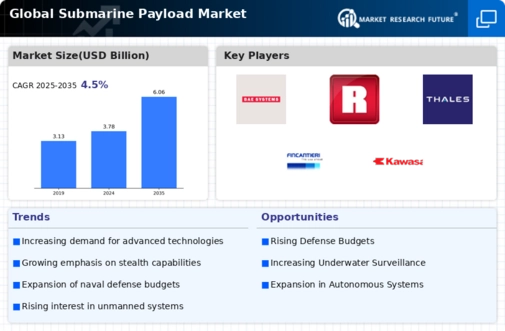Market Trends
Key Emerging Trends in the Submarine Payload Market
Market share positioning in the Submarine Payload sector involves strategic initiatives aimed at establishing a competitive advantage, ensuring technological leadership, and meeting the evolving needs of naval forces globally. Technological differentiation is a cornerstone strategy, where companies strive to lead in innovation by developing cutting-edge submarine payload solutions. Investing in advanced sensors, communication systems, and autonomous underwater vehicles (AUVs) allows manufacturers to differentiate their products and position themselves as leaders providing state-of-the-art undersea warfare capabilities.
Strategic partnerships and collaborations play a pivotal role in market share positioning within the Submarine Payload market. Forming alliances with submarine manufacturers, defense contractors, and technology providers enables companies to create comprehensive and integrated solutions. These collaborations contribute to the development of submarine payload systems that seamlessly integrate with diverse submarine platforms, enhancing interoperability and widening the market reach. Strategic partnerships also provide opportunities for joint research and development efforts, fostering innovation in undersea warfare technologies.
A customer-centric approach is instrumental in market share positioning in the Submarine Payload sector. Understanding the specific needs and operational requirements of naval forces allows companies to tailor their submarine payload solutions accordingly. User-friendly interfaces, adaptable configurations, and a focus on enhancing the overall operational efficiency contribute to market differentiation. Companies that prioritize customer satisfaction and engagement build long-lasting relationships, fostering loyalty and positive referrals within the global naval community.
Strategic marketing and branding efforts are crucial elements of market share positioning in the Submarine Payload market. Establishing a strong brand presence through targeted marketing campaigns, thought leadership, and participation in defense industry events enhances market visibility. A compelling and distinct brand image that communicates reliability, innovation, and a commitment to naval superiority can influence customer perceptions and preferences, ultimately contributing to a larger market share.
Cost-effectiveness is a significant strategy for market positioning, especially in an environment where defense budgets and procurement decisions are closely scrutinized. Companies that offer competitive pricing without compromising the quality and performance of their submarine payload solutions gain a competitive advantage. The ability to deliver cost-efficient technologies positions these companies favorably, especially in regions where budget constraints and cost-sensitive procurement practices are prevalent.
Regulatory compliance and certification are integral to market share positioning in the Submarine Payload sector. Adherence to stringent safety regulations, naval standards, and certification requirements is not only a legal necessity but also a key factor in gaining the trust of naval authorities and customers. Companies that demonstrate a commitment to regulatory compliance position themselves as reliable and responsible partners in the development and supply of submarine payload systems.
Global presence and strategic geographical positioning contribute to market share strategies in the Submarine Payload market. Establishing a strong international footprint allows companies to access diverse markets, respond effectively to global trends, and address region-specific challenges. Regional partnerships and a deep understanding of local regulations and customer requirements enhance a company's ability to position itself as a global player capable of meeting the varied demands of naval forces worldwide.
Innovation in sustainability initiatives and environmentally conscious technologies is gaining traction as a market share positioning strategy. Manufacturers are exploring eco-friendly materials, energy-efficient systems, and sustainable production processes to align with broader industry goals of reducing environmental impact. This strategy reflects a recognition of the importance of sustainability in defense technologies, including submarine payloads, and positions companies as contributors to global environmental responsibility.
Customization for specific submarine platforms and mission profiles is a prevalent strategy for market share positioning. With the diverse range of submarine designs and operational requirements, companies that offer submarine payload solutions tailored to meet the unique specifications of different submarines gain market traction. Customizable features, adaptability to various submarine classes, and compatibility with different mission scenarios contribute to market share positioning by ensuring optimal integration into specific naval platforms.








Leave a Comment